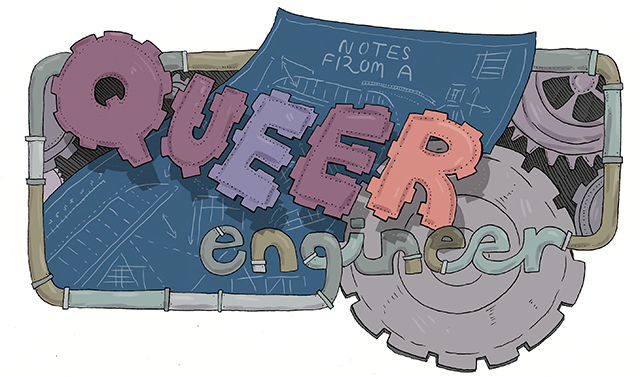 Header by Rory Midhani
Header by Rory Midhani
The past two months have been jam-packed for every woman in STEM I know. School went back into session, for one thing. The Mid-Autumn Festival in China created scheduling fluctuations for those of us who work in manufacturing. Ferguson happened, of course, along with a variety of unforeseen ripple effects. And, prompted by a recent study on sexual harassment, a fresh wave of personal anecdotes from women in STEM made the rounds. As we enter October, the stories of their pain continue to circulate and recirculate, around and around and around.
I love talking about women in STEM, but I find it deeply frustrating to watch this discussion pattern repeatedly play out. Is there anyone left who isn’t convinced that STEM has a problem with sexism? Okay, there probably is, but honestly: if they haven’t been persuaded yet, is there any magic combination of words that will do so? Of course I want women to speak freely about their experiences, but why is it still treated as necessary?
Dr. Danielle N. Lee, a biologist who has written powerfully about her personal experiences with discrimination in the past, wrote on Twitter:

I agree wholeheartedly. There’s a mountain of both empirical and anecdotal evidence on the table already. I want to strategize about moving it!
One thing I’ve been thinking about lately is how regular hiring practices perpetuate structural inequality. As an engineering student, my classmates and I were told over and over how much our “network” (aka “who you know”) mattered to our future success. One reason for this is that overall, half of all jobs are not publicly advertised; they’re largely filled via personal connections and friend-of-a-friend recommendations. For those on the hiring end, this practice saves time because it guarantees that some like-minded, trusted party has already pre-screened the applicant and found them to be a good fit. The downside of this, of course, is that because we live a society with heavy divisions along racial, class, and gender lines, companies who leverage their employees’ networks are likely to turn up candidates that are very much like their current employees. Currently, STEM jobs are overwhelmingly white and male. In-network hiring means that it’s very likely to stay that way.
Requiring more job openings to be publicly advertised definitely wouldn’t fix all of STEM’s problems, but I wonder if it might hasten progress. In the meantime, here are some highlights of women in STEM speaking out this past month. Let’s learn from their stories and try to make things better for the next round of discussion. It’s going to take a lot of creative solutions to get us where we need to be.
+ Science’s Sexual Assault Problem by A. Hope Jahren for the New York Times
A geobiologist gives a heartbreaking account of the sexual assault she experienced as a grad student doing fieldwork.
From the article:
I still love rocks and I still dream of the ancient Aegean seas, but for the better part of my career I’ve sealed myself into a locked laboratory, a small well-lit world that I can control. I still do fieldwork, but I do it in “safe” countries like Canada and Ireland — where similar things still happen. Where would I have ended up had I been the first person to report the isotope chemistry of the aquifers that underlie the ancient city of Hierapolis? I’ll never know, because I’ll never go back. I’ll take my chances elsewhere and let my male colleagues study the travertine deposits of the Menderes River Valley. I will continue to do everything right, and it will continue to keep me inadequately safe.
+ Thinking About What We Can Do About Sexual Assault And Harassment In The Sciences by Amy Parachnowitsch and Terry McGlynn at Small Pond Science
Ultimately, what causes a positive change in climate isn’t just a set of written policies. We need to embrace a clear set of values and priorities that guide on-the-spot decisionmaking at critical moments. Our lab members need us to not only set a personal example, but also respond to disrespectful behavior in the lab the moment it happens, and respond immediately and with full concern (and due process) when anecdotal reports come our way.
Hope Jahren’s piece makes us feel. But in my situation, my feelings don’t count for anything. It’s what happens in my lab, and the experiences of the students for whom I am responsible that matter. As PIs, responsible for the culture in our scientific community, our feelings only count if they cause us to act upon them.
+ “Voices in Science” by Emily Graslie
Spoken word poetry about some of the major issues women face in science:
+ Pushing Women and People of Color Out of Science Before We Go In by Jennifer Selvidge for the Huffington Post
I am a senior at the Massachusetts Institute of Technology (MIT), a materials engineer, an honors student, and a woman. I also have been told hundreds of times that I don’t deserve to be where I am. MIT admissions decisions come out on 3/14 (for Pi) every year. By 8 a.m. on 3/15 everyone in my high school knew I had been accepted. Tons of people came up to congratulate that day and afterwards but seemed strangely insistent on reminding me that “it is a lot easier to get in when you are a girl because they get so many fewer female applicants.”
+ Roma Agrawal On Bridging The Diversity Gap In Engineering and Inspiring A Future Generation on Nature.com’s Soapbox Science
There is a severe lack of awareness and understanding in what engineers do. I hear the word engineering used most when a train is running late, due to overrunning engineering works, but never in awe or wonder at a building and the engineering behind that. … Engineering needs a brand overhaul. Currently only eight per cent of women are engineers. We have this problem of what an engineer should look like or does look like, that was maybe accurate in the past, but isn’t today. There is a long way to go, but for me, it is important to show the diverse faces of engineering.

Agrawal: “We have this problem of what an engineer should look like or does look like, that was maybe accurate in the past, but isn’t today. There is a long way to go, but for me, it is important to show the diverse faces of engineering.” Credit: Nicola Evans, WSP. Via Nature.com.
+ Nature vs Nurture: Girls and STEM by Zuleyka Zevallos, Buddhini Samarasinghe and Rajini Rao for Nature.com’s Soapbox Science
It is social conditioning, unconscious biases and institutional practices that create an environment where girls feel unwelcome and insecure in STEM fields. UNESCO data show that women are disadvantaged in STEM, with only one in five nations achieving equality. But the cultural variation in itself tells us that it is socialisation and policy intervention, not biology, that matters. Research shows that institutional gender bias develops in several phases. First, children lack female scientist role models from primary school. Second, young undergraduates learn that science privileges a masculine culture, which makes it hard to imagine their career path. Third, diversity barriers are witnessed first-hand by early career researchers. Both male and female faculty are less willing to hire women applicants with the same credentials as men. Given these clear prejudices, we must move away from lazy explanations that attribute women’s under-representation in STEM to their biology. Instead, we must acknowledge that the system actively discourages women in ways both obvious and insidious. We must move away from the individual and address the broader narrative of everyday sexism.
+ Read The Nasty Comments Women In Science Deal With Daily by Macrina Cooper-White for Huffington Post.
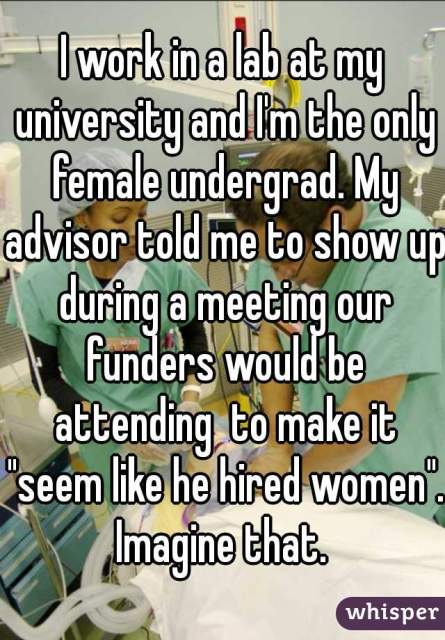
Via Huffington Post.
+ Addressing a Diversity Problem in Human Genetics by Jennifer Raff for the Huffington Post
We have a diversity problem in the field of human genetics. Less than 1 percent of the Ph.D.s in fields related to human genetic research go to Native Americans, and, according to Dr. Kim Tallbear of the University of Texas, they make up less than one fifth of 1 percent of the members of the American Society of Human Genetics. This is particularly troubling in light of a history of exploitative genetics research with Native American communities. Dr. Tallbear notes, “In many aspects we govern through science. If tribal communities don’t have people trained in genetics, we don’t have the ability to engage in meaningful conversation with geneticists.”
Participants at the Summer Internship for Native Americans in Genomics (SING) lab. Via Huffington Post.
+ Science Has A Thomas Jefferson Problem… by Dr. Isis on Isisthescientist.com
Life has a sexual assault problem. 26% of women scientists are assaulted in the field, but about that many women in general report sexual assault. A large portion of the attacks against scientists are perpetrated by someone the victim knew, but many women in general know their attackers. So, at the crux of the stunning and shocking and eye opening is something that I find more insidious – it is the belief that science is somehow different than society at large.
+ Where Are the Women in Makerspaces? by Georgia Guthrie at Makezine.com
If you’ve been to your local hackerspace/makerspace and noticed there weren’t many women, did you stop to wonder why? Unfortunately a common reaction is to think, “I guess women just aren’t into hacking or building stuff.” As one of the few female directors of a U.S. makerspace, I know this just isn’t true. Here’s my perspective on the problem and what can be done about it.
Camp Crescent. Via Makezine.
+ We Need To Talk About The Sexual Abuse Of Scientists by Margaret C. Hardy for TheConversation.com
As I recommended recently in the scientific journal Nature, a sexual assault and sexual harassment policy for research institutes would be immensely useful. In this way, a statement could be made in line with existing policy frameworks for academic, industry and government laboratories. But to honestly reflect the reality that men and members of the transgender community are also both researchers and rape survivors, the policy needs to be inclusive across the board.
+ Female Physicists Worldwide Fight Sexist Stereotypes by Clara Moskowitz for Scientific American
Women in physics tend to be outnumbered by men nearly all over the world. For a few days in early August, however, it didn’t feel that way when I attended the International Conference on Women in Physics in Waterloo, Canada. Hundreds of women from about 50 countries gathered there for talks, posters and brainstorming sessions to discuss both gender, physics, and the intersection of the two.
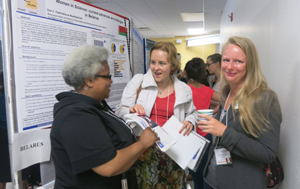
Three physicists meet at the International Conference on Women in Physics August 5-8, 2014 in Waterloo, Canada. Credit: Marina Milner-Bolotin/ICWIP. Via Scientific American.
+ Women Are The Face Of India’s Mars Mission, But They’re Still The Exception by Rhitu Chatterjee at PRI
Women in any field of science don’t usually make headlines in India. Bollywood movies don’t portray women as scientists, and neither does popular television. Women wearing bright saris and flowers in their hair are only ever shown as housewives or mothers or, at the most, in one of those professions considered acceptable for women, like teaching.
That’s not to say there aren’t women in science. I studied science in India before moving to the US and becoming a journalist. In my time, women scholars outnumbered men, at least in the field of biology. Higher education in physics, math and engineering was still mostly for the boys.
But for the women who did pursue careers in science, the path was never easy.
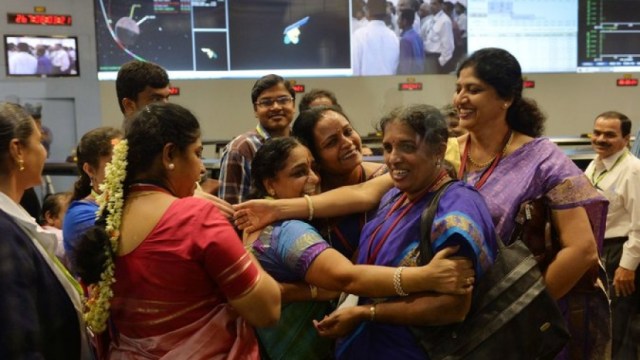
Staff from the Indian Space Research Organization celebrate at the ISRO Telemetry, Tracking and Command Network in Bangalore after their Mars Orbiter spacecraft successfully entered Mars orbit on September 24, 2014. Via PRI.
+ Women Scientists Get Vocal About Top Billing on Twitter by Victoria Metcalf at The Conversation
It is clear from responses to the Hall and Science articles that issues with how women are perceived and treated in science extends to social media too. The #WomenTweetScienceToo and alternative lists are a useful first response. But on reflection we need a far stronger, better call to arms due to the enormity of issues facing women in science. The trouble with lists is someone is always excluded, even other women in science.
+ Story Behind The Paper: Bonnie Baxter On “A Tale Of Salt And Gender” on The Tree Of Life
What we learned as we analyzed the conference participation in our field, is that we were doing quite well in gender balance of invited speakers, 36% of the speakers were women since 1978! And indeed, women had been included in many of the organizing committees. We saw a 10-16% increase in female speakers when this was the case. We also came to understand that there was a small group of scientists who were committed to holding this conference with no organizational funding. This led to cooperation, collaboration, avid mentorship and strong friendships. This was a group that welcomed women, young scientists and peoples of all nations.
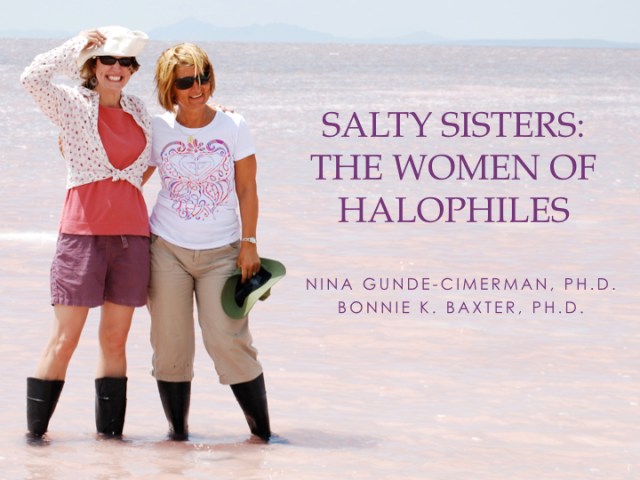
Dr. Bonnie Baxter and Dr. Nina Gunde-Cimerman at the north arm of Great Salt Lake (2008). Via The Tree of Life.
+ Getting Girls Into Physics – Are We Saying The Wrong Things? by Averil McDonald for EPS News
Then there’s another issue: the vocabulary. Social Scientists will point out that, on average, women talk about themselves or their life dreams using adjectives while men will use verbs. (Many female readers at this point will disagree, but of course you are the women who DID choose physics so you are used to working in a masculine world and may have adapted to masculine vocabulary/behaviour – I’m talking about averages). If all of our conversations with young people are based upon verbs, then many girls may not recognise themselves as being part of the picture. It is for this reason that many girls will agree that physics is important and it is interesting. But they will then conclude that ‘it isn’t for people like me’.
+ “Inclusion is a challenge all over. The Ada Initiative has resources to support women in *your* community.” by Janet D. Stemwedel for Scientopia
I have spent most of my life dealing with the default assumption that stuff I’m interested in — stuff I’m passionate about — is not for me, because I’m female. I’ve dealt with this in math and science, in philosophy, and online. I have dealt with harassment (in academia, online, in the wider world) that my male colleagues don’t face and often don’t even see when it’s happening right in front of them. I have grappled with my impostor syndrome in a cultural climate where others are already doubting my competence simply because I’m female.
This state of affairs is not OK with me.This is not a situation my daughters should have to deal with.
Via Scientopia.org.
+ When Words Fail: Women, Science, And Women-in-Science by Jacquelyn Gill at The Contemplative Mammoth
And, being a woman in science also comes with the expectation that I talk about being a woman in science; that I become an expert on everything that helps and hinders my progress; that I mentor my fellow women through the slog; that I have informed opinions on the latest issues facing my gender.
Being a woman in science comes with the expectation that I just shut up already about women in science and just do the damned science already. It also comes with the expectation that instead of my talking about my own experiences, I pay more attention to the experiences of others, particularly those who have their own opinions on whether I should even have opinions, whether about climate change, education, motherhood, or my own body.
Sometimes, the most radical thing I can do as a woman scientist is, well, science. You know, my job. My job that I love.
Notes From A Queer Engineer is a recurring column with an expected periodicity of one month. The subject matter may not be explicitly queer, but the industrial engineer writing it sure is. This is a peek at the notes she’s been doodling in the margins.
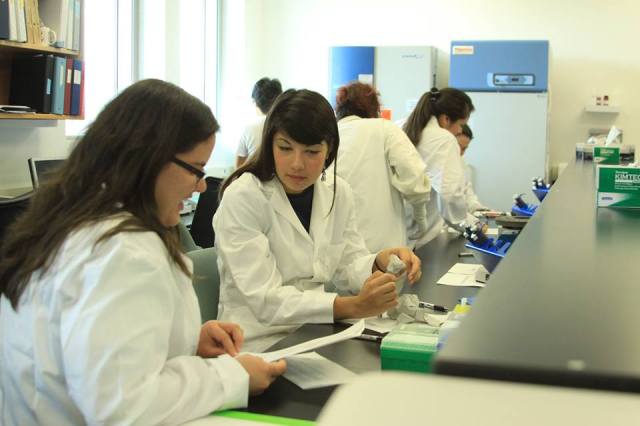
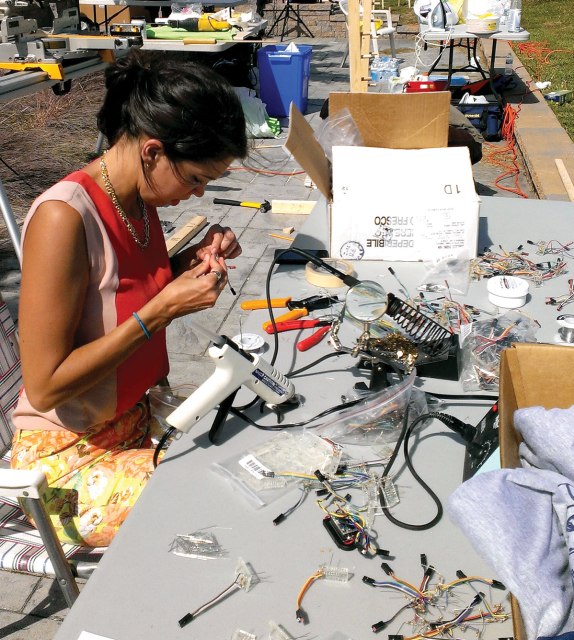


I would love to see you do an interview with Maria Klawe, currently President of Harvey Mudd College, who has done amazing things there in terms of building up the population of women in STEM fields and in making it a safer, more welcoming place for those women. She’s a force of nature.
@Willow Rose, I’m a student at Harvey Mudd College! Love the shoutout :) We would be overjoyed if Autostraddle came to campus!! As students at Mudd, we are a bit better acquainted with President Klawe. She is a bit more of a controversial figure here I’ll admit, but nobody can deny how much she has increased the accessibility of CS to women on campus. For that matter, last year we graduated more women engineers than men engineers, and computer science is becoming our most popular major. Women in STEM are a force to be reckoned with! It’s one of the few elite tech institutions with almost balanced gender ratios, which is really great but also can draw plenty of comments about people only getting in because they are girls… Doesn’t help the impostor syndrome. Anyhow, as a queer woman in STEM, I love these articles! Keep ’em coming!
That is all good to hear, emd! I’m obviously not tuned in to the details, but it’s clear that a WHOLE lot has changed in 30 years. (Yeah, I’m ancient.)
As a grad student in physics, this is my very favorite article. Although at least once a week I wonder how much more productive I would be if I didn’t have to spend so much brainpower thinking about sexism and lgbt issues.
Go female engineers! (I’m a geotech engineer myself). Defs needs to be more of us out in the field, especially queer ones.
:)
Slightly off topic, what frustrates me most about perceptions is that I’m fairly femme outside of work, I like floral scarves, my curly hair and dresses for nights out etc etc.. yet aside from all the sexist comments I get from the stone age males I occasionally come across (‘your head would look better on a pillow’ .. ‘you shouldn’t be bending over that trial pit you’re going to give me a bl**dy heart attack’ -.-) the majority of the (not so bad generic male workforce) even mutter into their coffee cups that I must be a lesbian (before knowing my sexuality) to do a job where I wear steel toecaps and use powertools etc. It’s not that I’m not proud to be queer, I just dislike the assumptions that I am because of the PPE requirements and roles of my job, and their again narrow-mindedness over the lesbian community.
*le sigh*
I’ve always wanted to go into computer science. Ever since I was a kid, computers have always been my one and only love, but it’s so hard to be taken seriously when asking for help with anything, on account of my being female.
people just disregard me, and make sexist jokes every time I get on a forum.
it’s driving me insane.
I always have to register as male in order to get any serious answers.
like christ on a cracker.
this is why we can’t have nice things.
It’s disheartening to see so many articles dealing with this problem, and yet most people don’t really believe that there’s a very real, very social deterrence for women to get into STEM. Thanks, Laura, for your continually awesome coverage of this stuff.
I didn’t go into science, but I’m still really grateful for a high school physics teacher I had who acted like it was a given that women could (and would) be good at science. And she was very consistent about including feminine names in example problems and stuff.
One person, but as a teacher she’s probably had a big impact.
ahhh thank you so much for this! I’m currently interning on a major international project relating to women in STEM and this is great material. (I’m trying to get them involved with Autostraddle somehow, but if you or any other readers want to help out in some capacity let me know!)
Such a good article. Thank you. And also really great reading material in the links.